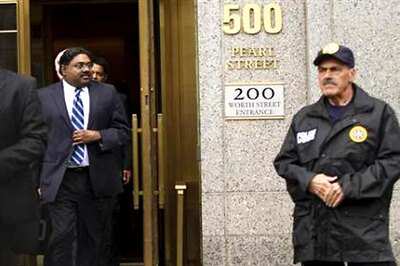
views
‘And now the time has come to say goodbye. As we turn the last page and put away the book, regret or bitterness has no place in our hearts. Instead, we may find content in the thought that what we did was worth doing, that we set our standards high and would not lower them, that we never need part with our memories,’ said JRD on July 31, 1953 in his final message to the staff of Air India on the eve of government’s take over. Those very memories—cherished and treasured by the House of Tatas—can be seen as the motivation behind the offer to take over and help restore the glory of the airlines their doyen had to part, with much grief and sorrow.
With the advantage of hindsight, one can safely claim that the business and economic policies implemented by the first government of post-1947 India under Jawaharlal Nehru afflicted India with a lifelong disease that promoted mediocrity and punished excellence; the saga of Air India is its first and the biggest symptom!
What Did India Lose during Air India’s Journey from Glory to the Monumental Failure?
An airline that redefined the air transport business world over and had several firsts to its credit became synonymous with inefficiency, deficient service, corruption, gross mismanagement and never-ending losses. Much has been written about what went wrong with Air India and how it lost; but let us look at this whole saga from the angle of India as a nation—and what it lost!
ALSO READ | Air India: Acquisition is the Easiest Part, Real Work for the Tatas Starts Now
Nationalisation Promoted Crony Capitalism and Mediocrity
What the Nehru government did in 1953 with the single stroke of the pen was not just limited to the nationalisation of Air India or shaking the foundations of the Indian air transport industry, it ended up weakening the overall cause of private enterprises in the country. Later, this watershed event became the foundational reason for many subsequent assaults on private entrepreneurship via nationalisation of banks, insurance and mining companies.
Arbitrarily changing accepted business and economic plans and policies and curtailing freedom to function and engage in the private enterprise became a new normal. The foundation of the crony capitalism in the country was well and truly laid with the introduction of License-permit Raj.
Excellence and Wealth Creation Was Sacrificed
Air India made a mark for itself in every sphere of air-flying experience and was known for its excellence across the world. Punctuality of Air India was such that people used to tell time based on the landing of Air India flights. It was this penchant for excellence that proved to be Air India’s nemesis after JRD, citing safety considerations, refused to submit to demands of Rafi Ahmed Kidwai—minister in Nehru’s cabinet—on the issue of Night Air Mail. The confrontation, coupled with the fast liquidating private airlines, led the government to decide on the nationalisation of private airlines, thus dealing a deathly blow to the fast-developing private airport transport sector.
Later, it became a template for government to do similar experiments in banking, insurance, both general and life, and mining. Wealth creation by private enterprises became a much-maligned word.
Possibility of Aircraft Industry Killed
Indian air transport sector was growing at a rapid pace in the early 1950s with scores of private airliners crisscrossing the entire country in 48 Dakotas in use. Much before, Indian aircraft industry also began taking shape with Walchand Hirachand setting up Hindustan Aircrafts Limited on December 23, 1940, at Bangalore. JRD Tata also floated Tata Aircraft in March 1942 to manufacture aeroplanes.
While Tata’s plan got shelved midway as the British government, to protect its industry, cancelled orders given to Tata. HAL’s journey was cut short, first by the Government of India acquiring 1/3rd stake in 1941, and then by its complete nationalisation in 1951. The nationalisation of airline companies proved to be the final death blow to any possibility of India becoming a powerhouse for manufacturing of commercial aircraft despite its early mover advantage.
ALSO READ | Air India Sale: On the back of Maharaja?s Wings, How Tata Sons Plans to Rule Sky
Liberalisation and Wastage of Precious Financial Resources
The air transport business was opened for the private sector following the liberalisation of the Indian economy. Consequent to loss of monopoly status, both national air carriers—Air India and Indian Airlines—began losing market share and kept seesawing between profits and losses. However, the downward spiral began in 2006-07 after Air India and Indian Airline registered losses of Rs 541 crore and Rs 230 crore, respectively. To stem the rising losses, the UPA government, on July 15, 2007, decided to merge Air India and Indian Airlines.
The policies of the UPA government vis-à-vis merged entity and arbitrary decisions led to the airline posting a loss of Rs 2,226 crore in its first year, which skyrocketed to a mind-boggling Rs 7,200 crore during the period between 2007 and 2009.The total debt of Air India, thanks to aircraft acquisition, swelled to Rs 38,423 crore by March 31, 2010. UPA government then decided to give a bailout package to the beleaguered airline and Rs 34,000 crores has been infused into Air India since then.
Notable is the fact that Air India, ever since its merger, has been suffering losses and its accumulated losses until March 31, 2020 stood at Rs 70,820 crore, with FY 21 seeing another Rs 9,500-Rs 10,000 crore loss. The total accumulated debt of Air India after the transfer of Rs 29,464 crore to the SPV is around Rs 43,000.
For perspective on the Air India losses and debt, note how –
* Total accumulated loss of almost Rs 80,000 is sufficient to build five new railway lines of the size of a Greenfield Rishikesh-Karnaprayag railway line or can help provide Rs 5 lakh Ayushman health benefit to almost 10 crore citizens.
* The total debt on Air India’s books can help fund the construction of 9,000-km long, four-lane highway or 5,250-km long, six-lane highway.
* Similarly, the bailout package given by the government to Air India over the last 10 years would have been sufficient to finance the Centre’s newly announced POSHAN project for two years.
Conclusion
More than Air India, it is India that paid heavily due to the Nehru government’s decision to nationalise the Indian air transport sector in 1953. A decision which JRD communicated to ‘his’ Air India board for the last time on June 21, 1953 by saying—“Grieved as I am that this venture to which I devoted so much thought, energy and time and for the success of which I have held such high hopes, has come to this end, my sorrow is tempered by the thought that our twenty-one years’ endeavour has not been in vain, that the work we pioneered is being carried on”.
It is Indian state’s moment to undo the grief the Nehru government heaped on private enterprises in general and JRD in particular, in 1953!
The author is a Chartered Accountant with interests in social entrepreneurship, culture, dharmic issues and agriculture. He has served as an Economic Advisor to Trivendra Singh Rawat, former CM of Uttarakhand. The views expressed in this article are those of the author and do not represent the stand of this publication.
Read all the Latest News , Breaking News and IPL 2022 Live Updates here.




















Comments
0 comment